Meghalaya – Culture and Tradition
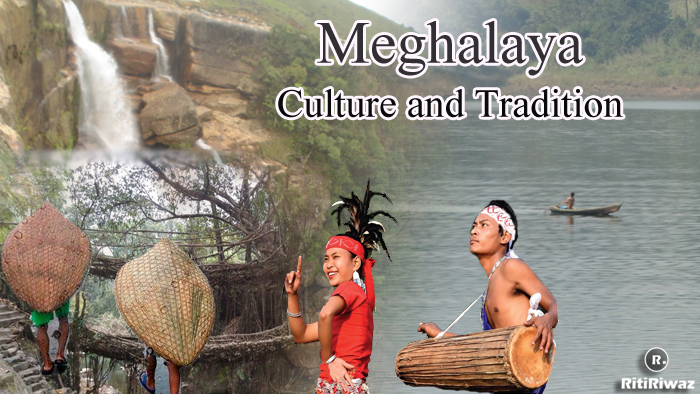
Meghalaya is a unique and small state in the north-eastern region of India, it is a paradise on earth. It means “the abode of clouds” in the Sanskrit language, and became one of the famous tourist destinations in India. The state has a lot of attractive things with vibrant culture, great scenic beauty, tradition, and peace, which attracts millions of tourists.
Assam to its north and Bangladesh to the south, and have Shillong its capital. Shillong is nicknamed “Scotland of the East“. It is one of the seven sister states of North-East India.
The climate of Meghalaya is subtropical (between hot and cold) and humid. Annual rainfall 1200 cm due to this, this state is called the most “wet” state of the country. Cherrapunji, which is south of the capital, Shillong, has set a world record of the highest rainfall in a calendar month. Whereas the village near this city Mavasinram holds the record for the most annual rainfall.
About one-third of the state is forested and the Garo, Khasi and Jaintia hills of the state are the major peaks, with stretches of valley and highlands plateaus, and it is geologically rich. Meghalayan forest is considered to be among the richest botanical habitats of Asia.
Nature has blessed her with abundant rainfall, sun-shine, virgin forests, high plateaus, tumbling waterfalls, crystal clear rivers, meandering streamlets, and above all with sturdy, intelligent and hospitable people. Intriguing limestone caves, mysterious living root bridges, sacred groves, majestic falls to misty hills, Meghalaya is the stuff travel dreams are made of.
History
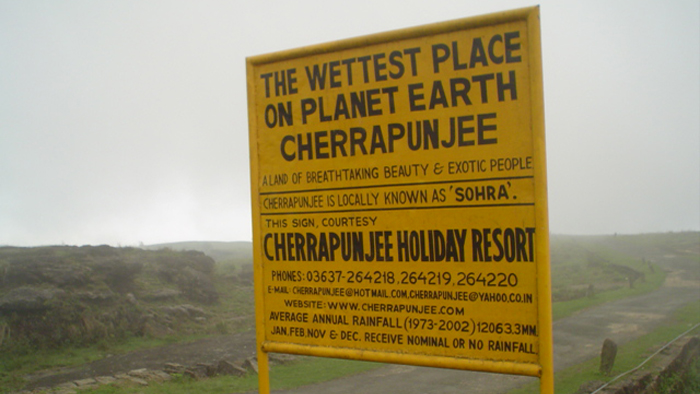
The early history of Meghalaya is not known, the Khasi, Jaintia, Bhoi, and War, collectively known as the Hynniewtrep people predominantly inhabit the districts East of Meghalaya, also known to be one of the earliest ethnic groups of settlers in the Indian sub-continent, belonging to the Proto Austroloid Monkhmer race. It was in the 18th and 19th centuries when the Khasi, Garo, and Jaintia tribes have their kingdoms.
In the 19th century, these kingdoms came under the British and were incorporated in Assam in 1835. Due to a treaty relationship between the kingdoms and the British, the region enjoyed semi-independent status for several years.
When Bengal was partitioned on 16th October 1905 by Lord Curzon, Meghalaya became a part of the new province of ‘Eastern Bengal and Assam’. However, when the partition was reversed in 1912, Meghalaya became a part of the province of Assam.
After Independence in 1947, Meghalaya was given autonomous status within Assam. However, the Meghalaya was not satisfied with the arrangement and started a peaceful and constitutional struggle for more independence. The State of Meghalaya has been conferred the status of an autonomous state under the Assam Reorganization (Meghalaya) Act of 1969.
The North-Eastern Areas (Reorganization) Act, 1971 was passed in the Parliament House in 1971, in which the state of Meghalaya was given the status of a total autonomy state. Meghalaya attained the existence of a full-fledged state on 21 January 1972.
The two districts of the state of Assam: The United Khasi Hills and Jaintia Hills and Garo Hills were formed as Meghalaya. The Garos inhabit western Meghalaya, the Khasis in central Meghalaya, and the Jaintias in eastern Meghalaya. It is now divided into seven administrative districts Jaintia hills, East Gam Hills, West Garo Hills, East Khasi Hills, West Khasi Hills, Ri Bhoi district, and South Garo Hills district.
Culture of Meghalaya

The main ethnic communities of Meghalaya include Khasis, Garo, and Jaintia. It is believed that people from these communities came to Meghalaya from South East Asia. The people of Meghalaya are known for their cheerful nature and adaptability.
Each community has its customs and cultural traditions the Khasis (of Mon-Khmer ancestry), the Garos (of Tibeto-Burman origin), and the Jaintias said to be from South East Asia. The common trait binding all three communities is its matrilineal system in which the family lineage is taken from the mother’s side.
While many people from the Khasi, Jaintia, and Garo communities have converted to Christianity hence we can easily see many churches, temples, mosques, gurudwaras, and monasteries in Meghalaya.
The region is rich in tribal culture and folk tradition. Dance and drinking along with the sound of buffalo horns, flutes, and mridangas form an integral part of the social ceremonies and religious ceremonies. Marriage relationships are outside their clan.
Suggested Read: Culture and Tradition of Indian States
Languages
English is the most spoken and official language of the state. The other main languages of the state include Khasi and Garo. Many other languages are also used in Meghalaya. For example, Panar, Tiwa, Baite, and Nepali language is used in almost all parts of Meghalaya state.
Most of the people in the cities use the English language and people in rural areas use different languages.
Costume
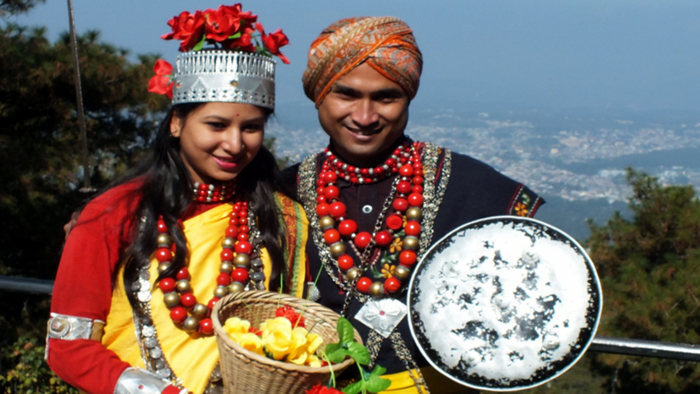
Meghalaya has three main tribes Khasi, Jaintias, and Garos, and the traditional dress of each tribe is peculiar. A skirt used by women is called Jympien which is either a cotton or endi type over which an apron (Kyrshah) is suspended from the left shoulder and loops down to the legs. In outdoor use, a Jainsem is applied suspended from over both the shoulders and looping down below the knee. Jainsem is a modification of the Indian saree, which covers the entire body and can be of cotton or silk.
A headcover is Tapmoh the upper ends of which keep the head enfolds and the two ends fastened behind the neck and from the neck, it loops below the cover of the upper part of the body. A mantle is draped from over the shoulders, its two ends begin tightened at the chest. It covers the lower end of the tapmoh and hangs down beneath the kyrshah which is a loose sort of shirting. The dress varies from place to place.
Adding to the beauty of Jainsem is beaded jewelry, this jewelry is currently a rage among the urban women who often pair them with their outfits- both western and ethnic.
The men of Meghalaya usually wear dhoti kind of apparel which is mostly unstitched and they pull on a jacket along with headgear or turban. Men’s dress is a sleeveless coat worn until the close of the last century, cotton cloth of thick texture having a fringe below. A waist girdle of cotton was worn beneath. Over the sleeveless coat Jymphong, a wrapper was suspended.
Jymphong is traditionally worn but only limited to festivals, in daily life you don’t see men sporting Jymphong. Later on, a dhoti was replaced for the waist girdle. A triangular car and wooden headgear were worn. Ordinary men wear mostly cotton clothes while Syiems and other dignitaries prefer silk patterns. Jeans and Jackets are common in daily wear.
Suggested Read: Traditional Dresses Of Indian States
Cuisines of Meghalaya
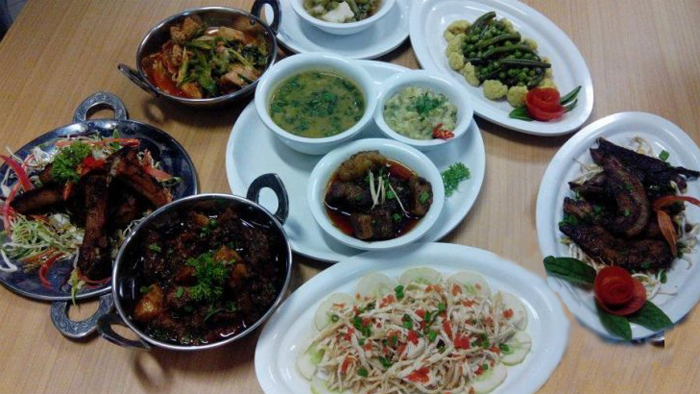
The main food of the residents here is rice, dried fish, and meat, it can be called a “Non-vegetarian’s” paradise. These hunting people are very fond of them, meat is their delicacy. They eat wild animals like deer, bison, wild pigs, fish, prawns, crabs, eels, and dry fish. They rear domestic animals like goats, pigs, fowls, and ducks only to feast on them. They take cooked, dried, and smoked meat and fish. Beef is popular in Meghalaya, you will find shops selling red meat in every corner of Shillong city. Arum plant and bamboo shoots are the daily items on the family menu, prepared in curries. There is a variety of edible mushrooms and tuberous roots eaten.
There are many varieties of food available, the common one is the traditional Garo food. Traditional Garo food includes boiled rice, different preparations of pork, beef, chicken, and dry fish. Some of the delicacies of Garo Food are Nakam Bitchi (it is dry fish made with chilies and soda), Wak Pura (it is Pork cooked with crushed rice).
Kyat is a local drink made of rice and beer and alcohol features in their everyday menu. They prepare rice beer, where rice is first boiled and sprinkled with some yeast. The preparation is laid in a ware, the mouth is covered with a plantain leaf neatly rolled. The ware is kept as it is for a few weeks until it is ready. Bear is also prepared from sticky millet and tapioca. Wanti is a specially prepared beer fermented rice and sprinkled with a special medicinal plant.
Suggested Read: Famous Food Of Indian States
Fair and Festivals
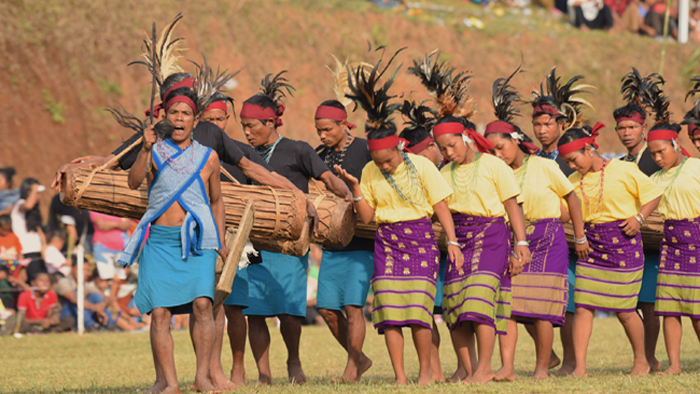
‘Pamblang-Nongkrem‘ of Meghalaya is a major religious festival of specialties. Which is celebrated for five days. It is also known as ‘Nongkrem‘. It is celebrated in a village called ‘Smit’, located about 11 km from Shillong. Shad Suk Minseem is an important festival of specialties.
This festival is celebrated every year in Shillong in the second week of April. ‘Bisinikhalam Jaintia‘ is an important festival for tribals. It is celebrated in the month of July in Jowai town of Jaintia Hills. The Garo tribes celebrate a festival called ‘Wangala‘ in October- November in honor of a deity named Saljong ( Sun God ). This festival is celebrated for about a week.
Garo: The Garo tribe people have their cultural heritage hidden in the festival itself. They often celebrate festivals dedicated to culture, religious events, and seasons. The Garo community celebrations include Dena Bilsia, Vangala, Rongchu Gala, Miamua, Mangona, Grengdikba, Jamang Siya, Ja Megapa, Sa Sat Ra Chaka, Ajeore Ahora, Dore Rata Dance, Chambil Mesra, Do Kra Sua, Saram Cha and A Se Mainia Etc.
Khasi: Dance is the main part of Khasi’s life and is also a part of his rites. The dance performances are performed in Schnog (village), Red (group of villages), and Hima (group of villages). The main festivals of the state include Ka Shad Suk Mynism, Kapom-blang Nongkrem, Ka-Shad Shyngving-Thangyeop, Ka-Shad-Kyenjo Khaskan, Ka Bam Khana Shanog, Umsnong Kharai, Shad Beh Sier.
Jaintia: The festivals of Jaintia Hill are similar to the Mahotsavos of another tribe. People here celebrate nature, balance, and solidarity. The Mahotsavos of the Jaintia community include Behreen Khalan, Laho dance, and sowing ritual ceremony.
Baite: Many festivals are celebrated in the Baite community on various occasions. But they do not celebrate many celebrations celebrated in ancient times today. Every year in January, a festival called Nulding Kut is celebrated, in which people of this community dance, enjoy music, and play traditional games. Also, worship is done in the temple.
Hajong: The people of the Hajong community observe Hindu customs. Every Hajong family has a temple called “Deoghar” to worship and they pray every morning and evening. The Hajongs live in groups and the area of the group is given the name “mercury or village”. Hajong village is not less than any empire. All the people of Hajong family living in the village have to take membership in the village. Hajong wears men’s Bhizgamsa and women’s Ranga Patheen and Fula Argo. People of Hajong community also perform folk dances.
Spirituality: Mavjiyambin cave is in southern Meghalaya. Here, the colossal pillar of nature has been given the shape of a Shivling. According to legends, this Shivling has been in the area of Rani Singa in the Jaintia hill since the 13th century. Every year thousands of devotees come here on the day of the Hindu festival Shivaratri.
Dance and Music
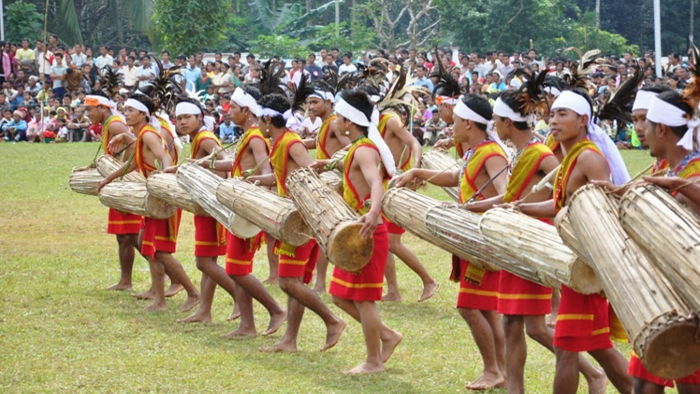
Meghalaya is the home of famous music and dance forms of North East India. The dances are associated with their festivals or seasons and hence enjoyed round the year. The dances are social, religious, agricultural, funeral, and recreational. The land resounds with the sound of perfect tempo, beautiful songs, and traditional instruments. The dances of Meghalaya are mostly held under the open sky.
They have their old war haunts, harvest, partner choice, and fertility dances. In almost all the festivals and ceremonies celebrations, there is the involvement of dance and music. Besides, there is a general dance where both men and women dance. They depict different moods and gestures reflecting cultural emblems.
The war dance (Grika) belongs to men, while women from the corners just cheer up. The harvest dance is Wangala, The partners or elopement dance (jikseka), girls and boys appear inappropriate gestures as if they were suitors approaching and advancing while girls expressed either decline or acceptance. The dance represents the plucking of fruits (chamdilroa) and group dance (chroka) is also performed.
Gariroa is a merry-go-round, boys taking a side on the left row and performing blowing of pipes and trumpets, beating gongs and drums in an orchestra while girls on the right row dance and hop forward and both go round and round in a circle. Musical instruments like mouth organs, tobacco pipes, flute, cup violin, tribal weapons, and so on are made of cane and bamboo.
Art and Crafts
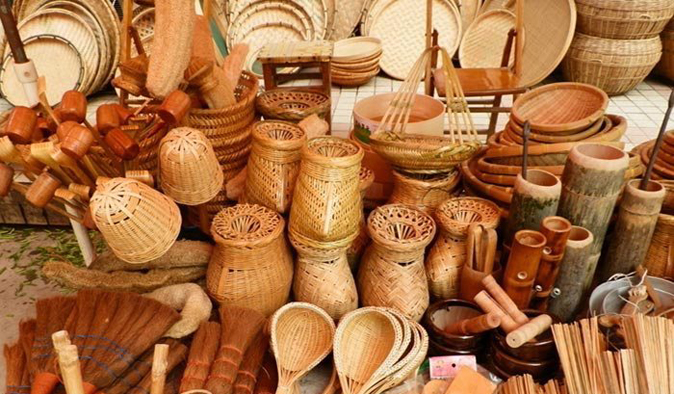
There are several crafts found in Meghalaya and the significant ones are cane and bamboo work, artistic weaving, and wood carving. Wood crafts are not transacted for trade. They are age-old motifs of artistic, decorative, and ceremonial value.
The people of Meghalaya consisting of three ancient hill communities – the Garos, Khasis, and the Jaintias have a special skill in crafting and making traditional bamboo and cane products. Most of the tribes are engaged in different types of handicraft making including bamboo and cane products.
The art and craft of Meghalaya have a uniqueness of their own. They are very intricately made and beautiful to look at. Tourists coming to this northeastern part are mesmerized to see the sheer wonder of the art and craft of Meghalaya. The abundance of bamboo makes it possible for artists to make bamboo and cane products. These products have now received recognition not only in the national market but also in the international market and are much in demand. Cane and bamboo product making is one of the prime occupations of the tribal people of Meghalaya. Cane and bamboo products like different household items, furniture, accessories, and musical instruments are made by the people.
Famous Personality
- U Tirot Singh: Chief of Khasi people
- Darwin Diengdoh Pugh: Former Chief Minister
- P. A. Sangma: Politician
- Arundhati Roy: Author
- Patricia Mukhim: Writer
- Udita Goswami: Actor
- Karen Shenaz David: British actress, singer, and songwriter
Tourism
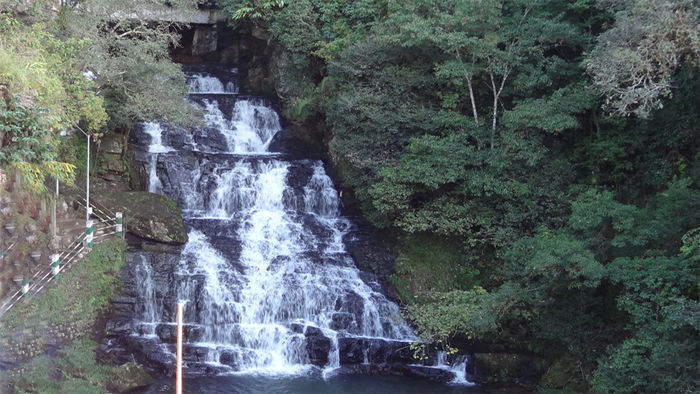
Meghalaya is one of the most beautiful places in India and offers abundant opportunities for adventure, rural, culture, and ecotourism. It has some of the largest forests in the country. Therefore, it is one of the most important ecotourism circuits in the country today.
Many types of flora and fauna are found in the Meghalaya sub-tropical forest. Meghalaya has a rich wildlife and has two national parks and two wildlife sanctuaries namely the Nokrek National Park and the Balpakram National Park the two wildlife sanctuaries are the Nongkhyllem Wildlife Sanctuary and Siju Wildlife Sanctuary.
The state of Meghalaya has many caves, mountain peaks, gardens, lake-resort sites, beautiful scenery, hot water fountains, and waterfalls. Major tourist places are Shillong, Umiam Lake, Cherrapunji, Mawsynram, Zakriyam, Myrang, Jowai, Nartiang, Thadalashin, Tura, Seju, and Balpakram National Park
Seeing the green instruments and their beauty, you feel as if you stop here and do not return. If you are planning to go to Meghalaya then definitely go to these places-
Ewduh Bara Bazaar, Shillong
The largest and traditional market in the Northeast, where you get to see the grand history of Meghalaya. People from different villages set up markets here and this is the main attraction of Meghalaya. You should go to this place.
Garo Mountains
This mountain is very beautiful. There is a very dense forest around it and you can enjoy trekking here. A quiet and relaxed area where you can see nature very closely.
Mawflang Sacred Forest
This place is present in the Khasi mountain, 45 km from Shillong. People from the Mavflang tribe live here. This place, which boasts of the unique beauty of nature, is a heritage in itself. There is a tree garden here which is very beautiful.
Nohkalikai Fall
Located about seven kilometers from Cherrapunji, this waterfall is very beautiful where people from all over India go for a walk. The story behind this is interesting. It is said that at this place there was a woman named Likai who got married after the death of her first husband and had a daughter with whom she loved very much. The second husband did not like this thing, so he killed the daughter and when Likai came home, she saw the daughter’s finger.
After this, the matter opened and Likai jumped into this waterfall after which its name was Nohkalikai.
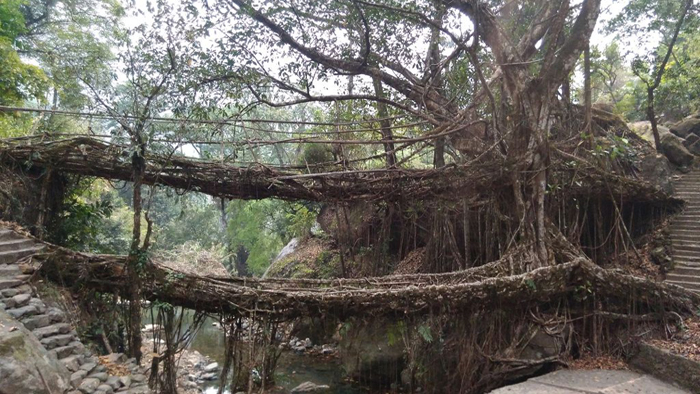
Root Bridge
Mavilong is a place near Cherrapunji where you will see amazing bridges made of trees and its twigs. People of the Khasi tribe live here and they have maintained them. It is very attractive and you feel as if you are back a hundred years. Thousands of people go to see them.
Mawsmai Caves
This place exists only a little away from Cherrapunji, where caves are present in a very systematic way. Walking in these places is challenging but also very exciting. You will get a different experience here.
Elephant Falls
It is about 12 kilometers from Shillong city. Earlier it was called Shaid Lai Panteg Khoshi but later it was changed by the British. You will find the smell of water falling from the top and the smell of litigants all around. Must visit this place.
Sweet Fall
It is present in Shillong which is very attractive. But it is also called Haunted because suicide incidents are very high here. It is surrounded by very beautiful scenery and is amazing in itself.
Mossmai Waterfall
You must visit this waterfall to see the unique beauty of nature and the wonderful work done by it. There is also a cave near it where water comes but it is not known from where. This place exists in the village of Mosmai near Cherrapunji.
Malang
A village located 24 kilometers from Shillong is counted among the cleanest villages in Asia. But the atmosphere here is more beautiful than it is clear. Surrounded by amazing views of nature, this village gives you great relief.
Nartiang
It is present in Jayanta Hills which is the most beautiful picnic spot in Meghalaya. It is said that the heart of Meghalaya resides here. Beautiful caves and the unique nature of nature and the accompanying adventure sports make you very happy.
These are the places in Meghalaya where you can go for a walk. Nestled in the lap of nature, this state remains the first choice of tourists due to its unique heritage.






